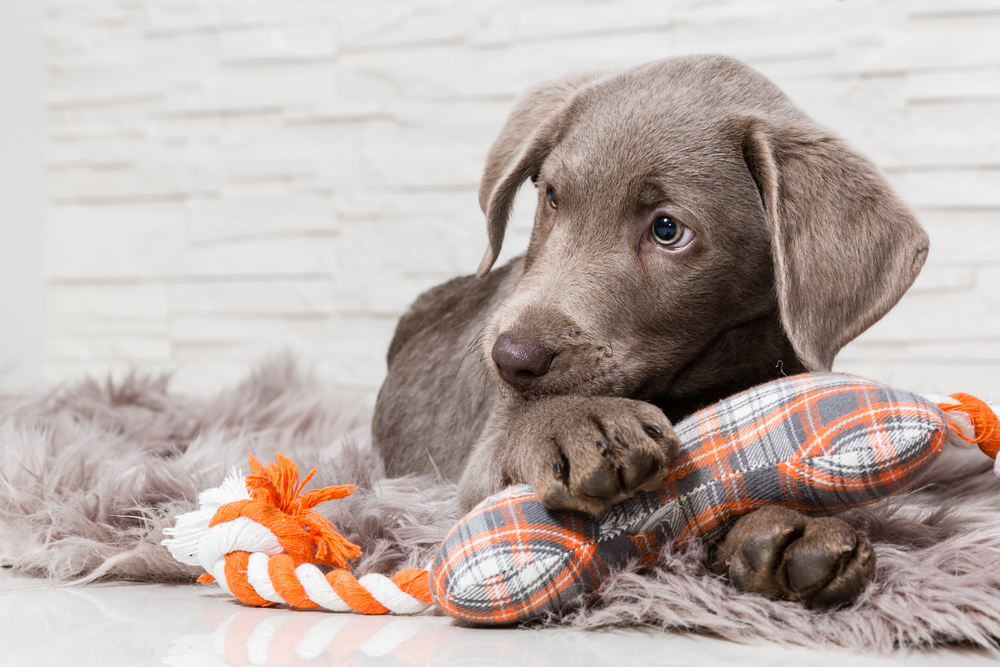Socialization can go wrong when people don’t recognize a puppy’s signs of fear. Here’s what to look for and how to avoid problems.
“We don’t understand where this aggression came from,” the woman said, tears in her eyes. “We took her everywhere as a puppy like you’re supposed to do. She went with us to stores, to our kids’ practices, to friends’ houses. She was fine! But now she growls at people and other dogs, even ones she’s met before.”
The Shepherd mix, Chloe, was now 1 year old, and barking at me from across the room. She would approach, then retreat, growl, and flinch every time I moved.
“Tell me about those early socialization visits,” I said.
“We started right when we got her at 9 weeks,” she replied. “She was fine! She was so quiet. Everyone would compliment her on being so well behaved.”
I asked, “When you introduced her to new people, did she run right up to them, all wiggly? Trying to kiss them? When she met other dogs, was she the same? All curvy and bouncy?”
“Oh no,” she said, “She was a quiet puppy. We would just put her in laps and she’d fall asleep half the time. She wasn’t interested in other dogs. They’d approach her, and she’d just look away like they weren’t even there. But she never growled at them until recently.”
Bingo. With further questions, I learned that Chloe rarely initiated contact with people or other dogs as a puppy. This puppy hadn’t been fine. She had been shutting down. She wasn’t well-behaved. She was too frightened to move. Now that Chloe was an adolescent, she was more willing to protect herself by barking and trying to scare away the people and dogs who frightened her.
Socialization Is More Than Exposure
My client was not a bad dog owner. She knew that socialization was important. She just didn’t realize that done improperly, socialization can backfire. Proper socialization is ensuring that a puppy has a variety of experiences, all wonderful ones. The puppy gets to decide if the experience is wonderful or not. In Chloe’s case, she wasn’t given the chance to go up to people of her own accord, at her own pace. She was placed in people’s laps – in essence, put in the laps of monsters. They were probably all very nice people, but Chloe didn’t think so. Her association with people became worse. When other dogs approached her, she signaled she didn’t want any interaction by turning away. Chloe’s mom didn’t understand that Chloe was uncomfortable, so she didn’t intervene. Now Chloe thought dogs were scary, too.
I’ve seen enough of these cases over the years that I’ve started to call them “Sleepy Puppy Syndrome.”
There are degrees of sociability in dogs, but a normal, healthy, confident puppy will want to explore. She’ll be curvy and wiggly. She may jump up to try and reach faces, trying to kiss chins. She’ll sniff and explore her surroundings.
Signs Of Fear And Stress
A puppy can whine, cower, and try to hide when she is afraid, but sometimes she will act sleepy.
Yawning is a sign of stress. Avoidance is, too. When a puppy is faced with something obvious, like another dog in her face or a looming stranger, and she starts sniffing the ground nearby, scratching behind an ear and ignoring the situation completely, this is a puppy practicing denial.
Understanding these signals can help prevent fear from blossoming into aggression as the puppy gets older. Always bring treats with you when you take your puppy anywhere. Pair each new experience with yummy cookies. If your puppy will not take the treats, it can also be a sign that she is too afraid.
It took three lessons before Chloe would let me pet her. I waited patiently for Chloe to approach at her own pace, rewarding each brave step with a liver treat. With a behavior modification plan and a dedicated pet parent who now understood how to work with Chloe’s fear, Chloe gradually learned the world was not full of monsters. In time, she learned to be truly fine after all.
This article was reviewed/edited by board-certified veterinary behaviorist Dr. Kenneth Martin and/or veterinary technician specialist in behavior Debbie Martin, LVT.








